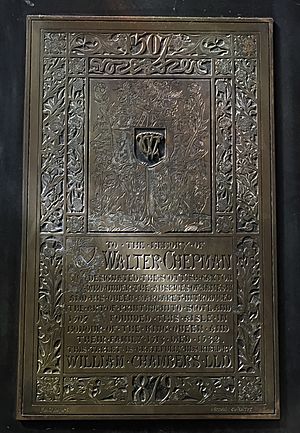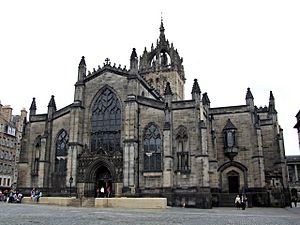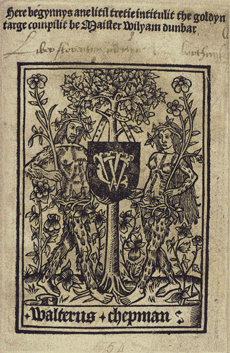Walter Chepman facts for kids
Quick facts for kids
Walter Chepman
|
|
|---|---|
| Died | 1532 |
| Nationality | Scottish |
| Occupation | merchant notary civil servant |
| Spouse(s) | Margaret Kerkettle (1st wife) Agnes Cockburn (2nd wife) |
Walter Chepman (died 1532) was an important Scottish merchant, notary (a legal helper), and government worker. He lived in the late 1400s and early 1500s. Chepman worked for the Scottish royal court when King James IV and King James V were in charge.
In 1508, Walter Chepman teamed up with Androw Myllar to start Scotland's very first printing press. Chepman also gave a lot of support to Saint Giles' Kirk (a church) in Edinburgh.
Contents
Walter Chepman's Life Story

Walter Chepman is first mentioned in official records in 1494. These records show he was paid for office work at the royal court. He continued to receive payments for this kind of work throughout his life.
Chepman was clearly a well-educated person. He worked as a notary, helping with legal documents, in and around Edinburgh. Working for the king also shows that King James IV trusted him. In 1503, the king even gave Chepman a suit of fancy clothes to celebrate his marriage.
A Successful Businessman
Walter Chepman was a successful merchant. He bought and sold fabrics and wood that came from other countries. He often supplied these goods to the King himself.
It seems he was a very wealthy man. He owned a large, seven-story building called a tenement on Edinburgh's Royal Mile. This is where he lived with his family. In 1507, he and Androw Myllar set up their printing workshop nearby.
Chepman was married twice. His first wife was Margaret Kerkettle. After she passed away, he married Agnes Cockburn.
Walter Chepman died in 1532. He was buried in a special chapel he had created inside St Giles Cathedral in Edinburgh. This part of the church is now known as the Chepman Aisle.
Scotland's First Printing Press
In September 1507, King James IV gave Walter Chepman and Androw Myllar permission to start a printing press. The King also gave them the only right to print books in Scotland. Androw Myllar was also a citizen of Edinburgh and a bookseller. He had previously sold books printed in France.
Chepman and Myllar's printing press was ready to use by the spring of 1508. It was located in the Southgait area of Edinburgh. They printed several important works.
One of their works was a church text called The Aberdeen Breviary. They also printed 'The Chepman and Myllar Prints'. These were a collection of small books with popular stories and poems written in Scots and English.
The printing press did not operate for a very long time. The last known book printed by them is an edition of the Aberdeen Breviary from 1510.
Supporting the Church
Walter Chepman paid to create two chapels at the Kirk of Saint Giles in Edinburgh.
The first chapel was built in 1513, next to the south side of the church. Here, special church services were held to remember Chepman, his first wife, and the King and Queen. Today, this part of the church is called 'The Chepman Aisle'. It holds the tomb of The Marquess of Montrose and a memorial plaque for Walter Chepman. This plaque was given by a publisher named William Chambers in the 1800s.
In 1528, Chepman also set up another chapel in the cemetery of Saint Giles' Kirk. This chapel, which no longer exists, was for special services. These services honored Chepman, both of his wives, King James V, King James IV, and all the Scottish people who died at the Battle of Flodden.



